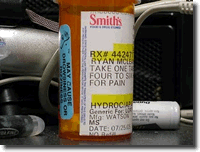About Drug Addiction
- Teen Drug Addiction
- Understanding Drug Addiction
- Effects of Drug Addiction
- Dangers of Drug Addiction
- Stages of Drug Addiction
- Signs of Drug Addiction
- Drug Addiction Withdrawal
- Drug Addiction Relapse
- Drug Addiction Facts
- Drug Addiction Overdose
- Drug Addiction Help
- Drug Addiction Intervention
- Drug Addiction Detox
- Drug Addiction Treatment
- Drug Addiction Rehab
- Drug Addiction Counseling
- What is a Drug Addict
- Drug Addiction Information
- Drug Addiction Statistics
- Drug Addiction Testing

Lortab Addiction
 Lortab is structurally related to codeine and is approximately equal in strength to morphine in producing opiate-like effects. The first report that Lortab produced a noticeable euphoria and symptoms of Lortab addiction was published in 1923; the first report of Lortab addiction in the U.S. was published in 1961. Every age group has been affected by the relative ease of Lortab availability and the perceived safety of this product by professionals. Sometimes seen as a "white-collar" addiction, Lortab addiction has increased among all ethnic and economic groups. DAWN data demographics suggest that the most likely Lortab abuser is a 20-40 yr old, white, female, who uses the drug because she is dependent or trying to commit suicide. However, Lortab-related deaths have been reported from every age grouping.
Lortab is structurally related to codeine and is approximately equal in strength to morphine in producing opiate-like effects. The first report that Lortab produced a noticeable euphoria and symptoms of Lortab addiction was published in 1923; the first report of Lortab addiction in the U.S. was published in 1961. Every age group has been affected by the relative ease of Lortab availability and the perceived safety of this product by professionals. Sometimes seen as a "white-collar" addiction, Lortab addiction has increased among all ethnic and economic groups. DAWN data demographics suggest that the most likely Lortab abuser is a 20-40 yr old, white, female, who uses the drug because she is dependent or trying to commit suicide. However, Lortab-related deaths have been reported from every age grouping.
This drug is just one of more than 200 other products that contain hydrocodone—is regulated by state and federal law, but it is not controlled as closely as other powerful painkillers. The lack of regulation makes them vulnerable to widespread abuse and addiction through forged prescriptions, theft, over-prescription, and "doctor shopping." Lortab pills have been sold for $2 to $10 per tablet and $20 to $40 per 8 oz bottle on the street.
Lortab is a narcotic that can produce a soothing state similar to heroin or morphine—and despite such important and obvious benefits in pain relief; evidence is pointing to many developing chronic Lortab addiction problems. Pure hydrocodone, the narcotic in Lortab, is a Schedule II substance, closely controlled with restricted use. But very few prescription drugs are pure hydrocodone. Instead, small amounts of are mixed with other non-narcotic ingredients to create medicines like Lortab. This means they can be classified under Schedule III with fewer restrictions on their use and distribution.
This medication has similar action on the user to codeine and mostly involves the central nervous system and smooth muscles. Though the precise mechanism of action is unknown, it is thought to relate to the opiate receptors of the central nervous system and similar to analgesia the drug produces mood changes, mental fogginess and drowsiness. Lortab is used to treat and control chronic or severe pain. The medication must be used in a careful and well-controlled manner because of the high risk abuse and Lortab addiction. Sometimes a patient can have absolutely no history of drug abuse and once prescribed Lortab, can become addicted within a period of several weeks. Some patients begin taking a prescribed dosage and go on to increase the dose of Lortab, some people with a severe Lortab addiction will go “doctor shopping” (hop from doctor to doctor) seeking to feed their Lortab addiction problem.
By altering the perception of pain at the spinal cord and brain, Lortab can induce an opioid analgesia effect in some patients. The side effects of Lortab medication also affects a person’s emotional response to pain and can have a stimulatory effect because it blocks inhibitions. With long-term Lortab addiction, an user can experience irreparable harm to the function of the nervous system.
Some people who have a Lortab addiction will exhibit obvious withdrawal symptoms. Others who have been taking the medication for a long period of time will go to great lengths to hide the physical signs and symptoms of addiction, making it hard to identify. For people who have chronic pain and do not have adequate pain relief, mood swings are common and mental illness can also mimic Lortab addiction.
Subject to individual tolerance, many medical experts believe dependence or addiction can occur within one to four weeks at higher doses of Lortab. Published reports of high profile movie stars, TV personalities and professional athletes who are recovering from Lortab addiction are grim testimony to its debilitating effects.
One way to gauge whether you or someone you love is physically addicted to Lortab is if withdrawal symptoms set in once you decrease use or stop it suddenly. Withdrawal is what happens when one’s body begins to detox from the drug. It can be quite challenging to detox from a Lortab addiction without the proper medical help. Opiate withdrawal syndrome can include muscle and bone pain, agitation, insomnia, restlessness, tremors, diarrhea, vomiting, other flu-like symptoms and involuntary leg movements. Finding the right Lortab addiction treatment program can help you to manage withdrawal symptoms and minimize discomfort.
Drug Addiction
- Alcohol Addiction
- Adderall Addiction
- Ativan Addiction
- Cocaine Addiction
- Crack Addiction
- Ecstasy Addiction
- Heroin Addiction
- Lortab Addiction
- Marijuana Addiction
- Meth Addiction
- Methadone Addiction
- Morphine Addiction
- OxyContin Addiction
- Percocet Addiction
- Ritalin Addiction
- Vicodin Addiction
- Xanax Addiction
